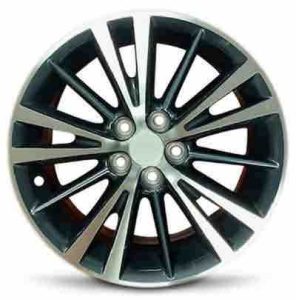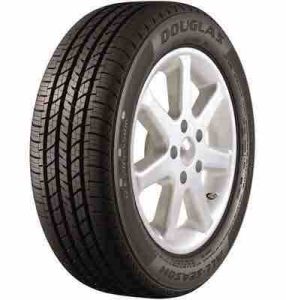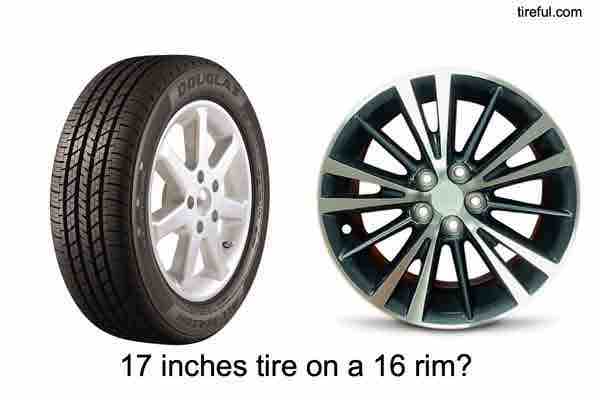No, you shouldn’t put 17 inches tires on 16 inches rim. They won’t fit.
And for some real-life experience let me tell you about my friend who took his new 17 inches snow tires off his BMW he was about to sell.
They were new tires and he didn’t want to add them to the package on account of how cheaply the car was being priced by prospects. He tried to put those 17 inches tires on his new Nissan with a 16 inches rim.
The result was more hilarious than it was ridiculous. One of the tires slipped off even before he finished jacking the car.
So, no. You can’t put 17 inches tire on a 16 inches rim.
Table of Contents
Major reasons why you can’t put 17 inches tires on 16 inches rim?
There are quite a few reasons why it would be a pure disaster to put 17″ tires on 16″ rims. When considering tire and rim compatibility, you must remember that tires must not just snugly fit on the rim, they have to tightly fit on it.
You have to consider the bolt patterns on the 16″ rim are specifically for 16″ tires. There are not many ways to put it, but the two components, tire, and rim, are not just meant to go together.
I have had this question asked in forums repeatedly and I always give the same answer: don’t do it, you’ll cause damages to your rim ultimately.
What size of tires do I need for 16 inches rims?

The following tires fit well on 16″ rims:
125/70-16 195/60-16 225/45-16 245/75-16
125/80-16 195/75-16 225/50-16 255/50-16
125/85-16 205-16 225/15-16 255/60-16
125/90-16 205/40-16 225/60-16 255/65-16
135/70-16 205/45-16 225/65-16 255/70-16
135/80-16 205/50-16 225/70-16 225/85-16
135/90-16 205/55-16 225/75-16 265/70-16
145/90-16 205/60-16 225/90-16 265/75-16
155/90-16 205/65-16 235/55-16 275/75-16
175/55-16 205/70-16 235/60-16 275/70-16
175/60-16 205/75-16 235/65-16 285/65-16
185-16 215/45-16 235/70-16 285/75-16
185/50-16 215/55-16 235/75-16 295/75-16
185/55-16 215/60-16 235/80-16 305/70-16
185/60-16 215/65-16 235/85-16 315/75-16
195/45-16 215/70-16 245/45-16
195/50-16 215/75-16 245/50-16
195/55-16 215/85-16 245/70-16
The numbers in the table above are codes that show what sizes of tires are to be mounted on specific rims.
Many folks get help at the tire shop when they need to replace their tires, they do not have to put any effort into understanding these codes. I usually advise vehicle users to be familiar with the meaning of these codes though.
Let us pick one of the codes, say, the last one, 245/70-16.
The number 245 points to the width of the tire, from sidewall to sidewall, in millimeters. The number 70 refers to the aspect ratio of the tire.
This is the profile height of the tire’s sidewall. In other words, the height of the sidewall of that tire is 70% of 245 millimeters of the tread width.
The last number, which is the focus of this article is 16 and this refers to the size of the wheel this tire will be mounted on. That is 16 inches rim.
Note that all the tires in the table all have either different sidewall heights or tire widths but the same rim size which is 16 inches.
Hence, if you have 17 inches tires, make sure you are mounting them on 17 inches rims. That way you avoid sad endings on the highway.
In what cases can you use 17 inches rim tires on 16 inches rim?

Great question nonetheless, and I have personally seen this question raised in a group of car users as well.
And the answer is: there are no exceptional cases where it works. The exigency of the particular time or moment does not have anything to do with which tire goes on which rim.
Rims and tires are manufactured following strict measurement rules. Your 16-inch rim can never be modified to accept a 17″ tire.
Sorry dude, you’ll just have to buy either a 17 inches rim or a 16 inches tire, as the table above indicates.
Which is better: A 17 inch or a 16-inch wheel?
For perspective, the smaller the wheel, the higher the sidewall, the bigger the wheel, the smaller the sidewalls.
Now sidewalls are very vital in the performance of tires on the road. Sidewalls absorb most of the impact on the road while driving.
A high sidewall absorbs more impact when the tire hits the side of a pothole than a thinner sidewall would. Hence, when choosing which rim you want to purchase; a 16″ or 17″ – consider this factor.
If you are buying a low-profile tire, for example, you know you are dispensing with the benefits of a high sidewall because it means your rims will be nothing smaller than a 17″ rim.
16″ wheels are better for utility cars and vehicles that you drive on the city roads. Especially if you live in neighborhoods where the roads are not so great, or where the roads are not smooth.
Will 17″ tires fit 17″ rims?
Yes, they will fit perfectly together. Any 17″ tires will fit on a 17″ rim well.
Moreover, as noted previously, a 17″ tire means you will have thinner sidewalls on. That tire will fall in the category of low-profile tires.
Your driving will be harder because the tire patch is wider and grips the road with all its surface.
You’d enjoy better cornering and a whole lot of advantage for sudden stops when you step on the brakes. But you may not have plenty of choices in the matter if you already have a 17″ rim on your car.
Can you fit an 18″ tire on a 17″ rim?
No. You shouldn’t try to. It won’t work. You can put an 18-inch tire on an 18-inch rim. Not lower.
What will happen if you attempt to do this still? Well, not much. Especially if you do this by yourself in your garage. For one thing, the tire will not fit, and if it doesn’t fit, you can’t tighten the bolts on.
You won’t even get to the point where you have to put air. Who knows, it just might not even take air. I haven’t tried this before, because it is needless. But if you go and do it, I’d like to get your feedback on what happened.
What size tires can you put on a 17 inch rim?
When it comes to tire sizes for a 17 inch rim, there are a few factors to consider. The most important factor is the width of the rim itself.
For example, a 17×7 inch rim can typically accommodate tire sizes ranging from 205/50R17 to 235/45R17. However, a wider rim such as a 17×8 inch rim can accommodate wider tire sizes ranging from 225/45R17 to 255/40R17.
So again, you want to choose a tire size that’s appropriate for the rim width to ensure optimal performance, safety, and stability.
Don’t forget to stick to the manufacturer’s recommended tire size for your specific vehicle to ensure compatibility.
Are bigger rims better than smaller rims?
No, not necessarily. It is only a matter of preference. Most who go for big rims do so more for aesthetic reasons than anything else. Big rims mean bigger tires, and bigger tires really do look fancy on your car.
If you are trying to make a decision about bigger rims here are a few pros and cons:
The pros of buying bigger rims
- Bigger wheels handle better on the road. When driving the car feels more rooted on the road, you can almost hear the tires swirling around. Most people who use bigger wheels talk about the comforting noise of driving on a quiet highway.
- Bigger wheels have better road performance than smaller wheels. They negotiate corners better, create better brake handling, and come to a stop faster.
- Bigger wheels make your car stand out in the parking lot. It is easily noticed on the road when you drive by.
The cons of buying bigger rims:
- Bigger rims can cause problems for your suspension and brake system if the extra weight is too heavy because wheels are metal, heavier than rubber and air.
- With bigger wheels, you’d need low-profile tires to compliment the extra size. Consequently, even though your driving just becomes more enjoyable, potholes and curbs become your new nightmare. Thinner sidewalls of low-profile tires can cause pinch flats when the tire hits the curb at a bad angle or when the tire bumps into potholes.
- The extra weight of your bigger rims affects your car in other ways like taking longer to stop on account of all the weight it now logs around, the overall size of the tire may rub against the mudflaps of the car’s damaging parts.
- Your speedometer suffers confusion when the tires speed faster than it can compute the speed. You’d have to adjust your speedometer to match the speed bigger wheels give the car. The bigger wheels turn the same way the smaller ones did, but now the car is faster.
17 inch truck tires on 16 inch rims: is it good?
No, it is not recommended to use 17 inch tires on 16 inch rims for your truck. Tires and rims should match in size to ensure proper fit, handling, and safety.
For example, my 2021 Ford F-150 comes with 17-20 inch rims, but varies from others depending on the trim level and tire size. I usually follow the manufacturer’s recommendations for tire and rim sizing to maintain the truck’s safety and performance.
Using an improperly sized tire and rim combination, for truck or any car design, can lead to damage to the tire, rim, or suspension, as well as negatively impact the vehicle’s overall performance.
Final notes on rims
The proper size of rims on your car goes beyond aesthetics. Rims do not only enhance the looks of your car, but they also determine stability and performance to a large extent.
Rims give your car leverage during movement, and also reduce friction between the tire and the car itself. Rims are really underrated and seldom talked about when it comes to performance.
They are to your car, what the human skeleton is to the body, at least, to a great degree. When considering changing your rim, whether from a small one to a bigger one, be sure to choose a good rim.
Find a rim size that matches your car not just aesthetically, but also for the sake of performance. A smoother ride is even more important than great looks, you will find.

